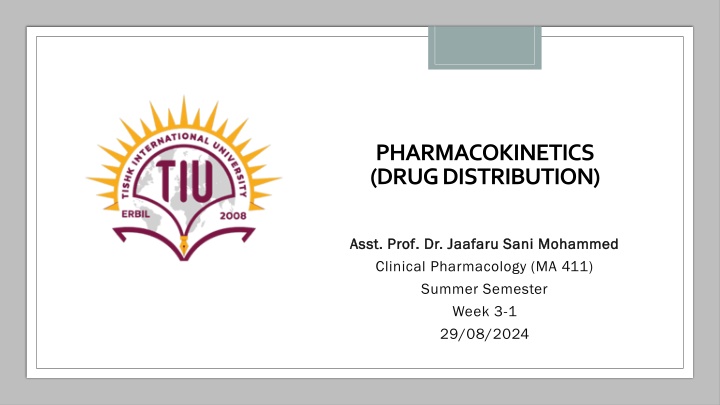
Understanding Drug Distribution in Pharmacokinetics: Key Concepts and Significance
Explore the principles of drug distribution in pharmacokinetics, covering topics such as tissue distribution, volume of distribution, drug binding, accumulation in tissues, and the role of the blood-brain barrier. Gain insights into the importance of drug distribution for effective pharmacokinetics and the regulation of drug entry into brain cells.
Download Presentation

Please find below an Image/Link to download the presentation.
The content on the website is provided AS IS for your information and personal use only. It may not be sold, licensed, or shared on other websites without obtaining consent from the author. If you encounter any issues during the download, it is possible that the publisher has removed the file from their server.
You are allowed to download the files provided on this website for personal or commercial use, subject to the condition that they are used lawfully. All files are the property of their respective owners.
The content on the website is provided AS IS for your information and personal use only. It may not be sold, licensed, or shared on other websites without obtaining consent from the author.
E N D
Presentation Transcript
PHARMACOKINETICS (DRUG DISTRIBUTION) Asst. Prof. Dr. Jaafaru Sani Mohammed Asst. Prof. Dr. Jaafaru Sani Mohammed Clinical Pharmacology (MA 411) Summer Semester Week 3-1 29/08/2024
Outlines Objectives Introduction Distribution to tissues Volume of distribution Drug binding Drug accumulation in tissues Blood brain barrier Summary
Objectives At the end of the lesson, the students should be able to understand: Key pharmacological action. role of drug distribution for effective The pharmacokinetics. importance of volume of distribution in The distribution. effect of drug-protein binding in drug How blood brain barrier (BBB) regulates the entry of drugsandother molecules into the braincells.
Introduction Drug distribution refers to the movement of a drug to and from the blood and various tissues of the body
Distribution To Tissues Distribution is generally uneven because of differences in blood perfusion, tissue binding (eg, because of lipid content), regional pH, and permeability of cell membranes. After a drug enters the systemic circulation, it is distributed to the body s tissues. Distribution equilibrium (when entry and exit rates are the same) between blood and tissue is reached more rapidly in richly vascularized areas, unless diffusion across cell membranes is the rate-limiting step. The entry rate of a drug into a tissue depends on the rate of blood flow to the tissue, tissue mass, and partition characteristics between blood and tissue.
Cont. oThe apparent Volume of Distribution is the theoretical volume of fluid into which the total drug administered would have to be diluted to produce the concentration in plasma. E.g. if 1000 mg of a drug is given and the subsequent plasma conc. is 10 mg/L, that 1000 mg seems to be distributed in 100 L. Mathematically: Dose/volume = concentration. 1000 mg/xL = 10 mg/L Therefore,x= 1000 mg/10 mg/L = 100 L.
Volume of Distribution oVDhas nothing to do with the actual volume of the body or its fluid compartments. oIt rather involvesthe distribution of the drug within the body. oFor a drug that is highly tissue-bound, very little drug remains in circulation; thus, plasma conc.is low and the VD is high. oDrugs that remain in circulation tend to have a low VD.
Cont. oVD provides a reference for the plasma conc. expected for a given dose but provides little information about the specific pattern of distribution. oEach drug is uniquely distributed in the body. Some distribute mostly into fat, others remain in ECF, & some bound extensively to specific tissues. oMany acidic drugs (e.g.warfarin,aspirin) are highly protein-bound and thus have a small apparent VD. oMany basic drugs (eg,amphetamine) are extensively taken up by tissues and thus have an apparent VDlarger than the volume of the entire body.
Binding oThe extent of drug distribution into tissues depends on the degree of plasma protein and tissue binding. oIn the bloodstream, drugs are transported partly in solution as free (unbound) drug and partly reversibly bound to blood components (eg, plasma proteins, blood cells). oThe most important plasma proteins that interact with drugs are albumin, alpha-1 acid glycoprotein, and lipoproteins.
Cont. oAcidic drugs are usually bound more extensively to albumin; basic drugs are usually bound more extensively to alpha-1 acid glycoprotein, lipoproteins, or both. oOnly unbound drug is available for passive diffusion to extravascular or tissue sites where the pharmacologic effects of the drug occur. oThus, the unbound drug concentration in systemic circulation typically determines drug concentration at the active site and thus efficacy of the drug.
Cont. At high drug conc., the amount of bound drug approaches an upper limit determined by the number of available binding sites. The saturation of binding sites is the basis of displacement interactions among drugs. Drugs bind to many substances other than proteins and it is usually occurs when drug is associates with a macromolecule in an aqueous environment when a drug is partitioned into body fat. Because fat is poorly perfused, the equilibration time is long, especially if the drug is highly lipophilic.
Accumulation of drugs in tissues or body compartments can prolong drug action because the tissues release the accumulated drug as plasma drug conc. decreases. E.g. thiopental is highly lipid soluble, rapidly enters the brain after a single IV injection. Some drugs accumulate within cells because they bind with proteins, phospholipids, or nucleic acids. E.g. chloroquine conc.in white blood cells and liver cells can be thousands of times higher than those in plasma. Drug in cells is in equilibrium with the drug in plasma and moves into plasma as the drug is eliminated from the body.
Drugs reach the central nervous system (CNS) via brain capillaries and cerebrospinal fluid (CSF). Although the brain receives about one-sixth of cardiac output, drug penetration is restricted because of the brain s permeability characteristics. Although some lipid-soluble drugs (eg, thiopental) enter the brain readily, polar compounds do not. The reason is the blood-brain barrier, which consists of the endothelium of brain capillaries and the astrocytic sheath.
Cont. The endothelial cells of brain capillaries (appearedto be more tightly than other capillaries) slow or stop the diffusion of water- soluble drugs. The astrocytic sheath of BBB consists of a layer of glial connective tissue cells (astrocytes) close to the basement membrane of the capillary endothelium. With aging, the BBB become less effective, allowing increased passage of compounds into the brain.
Cont. oDrugs may enter ventricular CSF directly via the choroid plexus, then passively diffuse into brain tissue from CSF. oAlso in the choroid plexus, acidicdrugs like penicillin) are actively transported from CSF to blood. oThe drug penetration rate into CSF, similar to other tissue cells, is determined mainly by: The extent of protein binding Degree of ionization, and lipid-water partition coefficient of the drug.






















